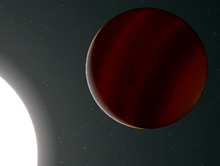WASP-18 b

WASP- 18b (also spelled “WASP-18b”) is an extrasolar planet orbiting the star WASP-18 . Its orbital period is less than a day. It is assumed that in about a million years there will be a collision between the planet and its central star.
more details
The planet was discovered on August 26, 2009 by Coel Hellier, astrophysics professor at Keele University (in England), who is part of an international research team, as part of the SuperWASP project .
The planet, classified as a gas giant with about 10 Jupiter's masses, is about 1 million kilometers away from its star WASP-18. Its atmosphere probably has neither water vapor nor oxygen, but is saturated with carbon monoxide. The mass ratios and the distance to the star mean that the giant planet orbits its central star in 0.94 days. The planetary system is about 325 (other source: 1,000) light years from Earth and is located in the constellation Phoenix .
Since tidal forces act on both the star and the planet in such a constellation, this frictional force reduces the speed of the planet. According to calculations, this will mean that the planet will evaporate in the central star in an astronomically very short time of 1 million years. Scientists at Keele and the University of Maryland are trying to find out why the planet, with its extremely close orbit, has not yet collided with its star. Because it is extremely unlikely to find a planet that will vanish in such a short time, scientists have doubts about the physical assumptions made here. They assume that they will be able to use the measurements that will take place over the next decade for reconnaissance. In our solar system there is a similar case: The Mars - satellite Phobos moves around 6,000 kilometers from the Martian surface away and needs to orbit around Mars less than eight hours.
See also
Individual evidence
- ↑ a b c A strange giant planet . In: Neue Zürcher Zeitung . 2009.
- ↑ Suicidal planet seems on death spiral into star. ( Memento of the original from September 1, 2009 in the Internet Archive ) Info: The archive link was inserted automatically and has not yet been checked. Please check the original and archive link according to the instructions and then remove this notice. at: Breitbart.com , from August 26, 2009. (English)
- ↑ Evidence for a Dayside Thermal Inversion and High Metallicity for the Hot Jupiter WASP-18b at: The American Astronomical Society , November 29, 2017 (English)
- ↑ The death planet. at: Telepolis . August 27, 2009.
- ↑ Gravitational effect: exoplanet dances on a deadly path. on: Spiegel Online . August 28, 2009.
- ↑ Astrophysicists puzzle over planet that's too close to its sun. In: Los Angeles Times . August 27, 2009. (English)
Web links
- Astronomers find “impossible” planets. on: Scienceticker Astro. August 26, 2009.
- An orbital period of 0.94 days for the hot-Jupiter planet WASP-18b. In: Nature . August 27, 2009. (English)
- WASP-18b (English) - EPE entry , September 8, 2009.
- Why Does Exoplanet WASP-18b Exist?

